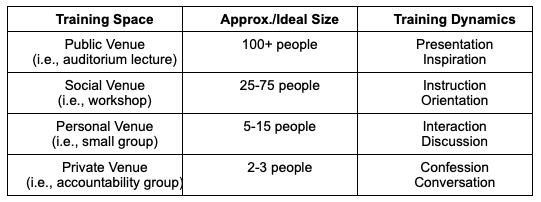Harvey Firestone stated that “the growth and development of people is the highest calling of leadership.” Yet, most organizations and churches struggle with developing their staff and employees. Long gone is the day when getting a degree before entering the workforce was sufficient to provide the necessary training for your job and career. For many, that’s just the starting blocks to get you going. Continuing staff development and training is critical to your organization’s or church’s success, especially for creating staff satisfaction and engagement. As Gallup has discovered, people no longer want bosses – they want coaches who train them to grow and flourish in their jobs and, ultimately, their careers.
In this article, I want to explain the different training elements that need to be in play and share why I believe we often get stuck as leaders developing others. Charts help us chart our journeys forward, so I have provided some charts to orient and guide our time together – to equip and help you shape training opportunities and pathways in your organization or church.
Phases of Training

For training and development to be productive and successful requires sequence and rhythm that leverages the situation, needs, and context of the individual. The above chart gets to (using familiar terms from the field of development) the core of training, apprenticeship – a movement from modeling to monitoring. This requires relational intentionality and investment. Many churches struggle here. From my experience and vantage point, most church leaders want to hyper-speed their staff development from Phase 1 to 4, without the time and attention given to Phases 2 and 3 – an “I do” to an immediate, “You Do” process. This does not work. Essential to developing staff is an ongoing residency-like process where Phases 2 and 3 are not neglected; and where there is regular feedback and accountability on the staff member’s actions, behaviors, attitudes, and outcomes. What are you doing in your context to honor and embody all phases of the training journey with your staff? What needs addressing? Is any phase missing?
Components of Training

Training needs to be holistic. It needs to give attention to the head, hands, and heart. Our heads need direction, clarity, and insights; our hands need experiential, on-the-job, skill development, and practice (simulations and role play can be helpful here); and our hearts need psychological safety and motivation. Additionally, our training needs to incorporate visual, auditory, and kinesthetic learning dynamics. As you develop your staff, are you providing a full-orbed process that attends to all human learning and growth dynamics? What components do we need to add? Simply filling people’s heads with information will not suffice – yet, it continues to be a primary way of training people.
Venues of Training

Many are familiar with the classic Pyramid of Learning that shows retention levels from the form of learning one experiences: lecture (5%); reading (10%); audio-visual (20%); demonstration (30%); discussion (50%); practice doing (75%) and teaching others (90%). Certain training venues are more conducive to certain elements of learning and retention. We need to provide all the training spaces to ensure our staff is fully engaged and developed. Unfortunately, most of our training in the church space leans toward the public and lecture venue.
The goal is to integrate the above training elements into a pathway that provides career growth and development for your staff. This requires energy, intentionality, and creativity, but it is worth the effort.
At Chemistry Staffing, we want to see churches develop their staff, and because of this, we are committed to serving church leaders to resource and support them in that effort. If you would like to create a robust staff development process in your context to see them flourish and excel in their career, please reach out to us. We would love to have a conversation about how we can help you champion your staff in this way!
Resources to Check Out:

